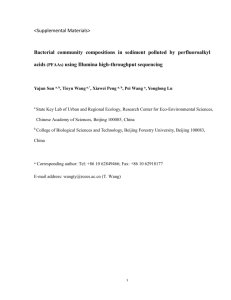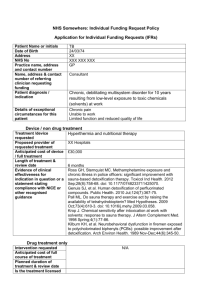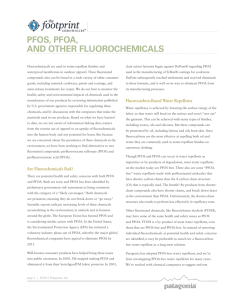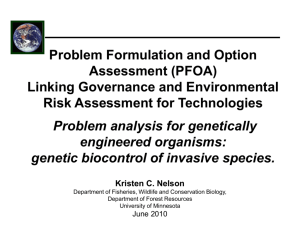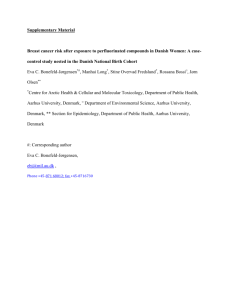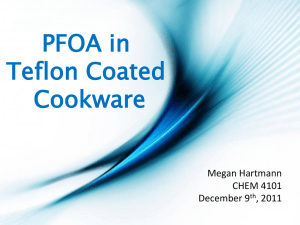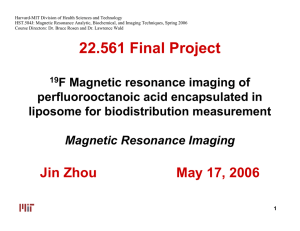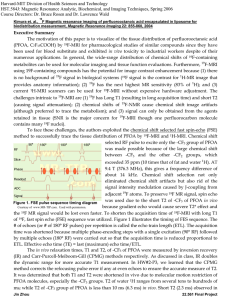GM FISH AND THE RISK ASSESSMENT PROCESS
advertisement
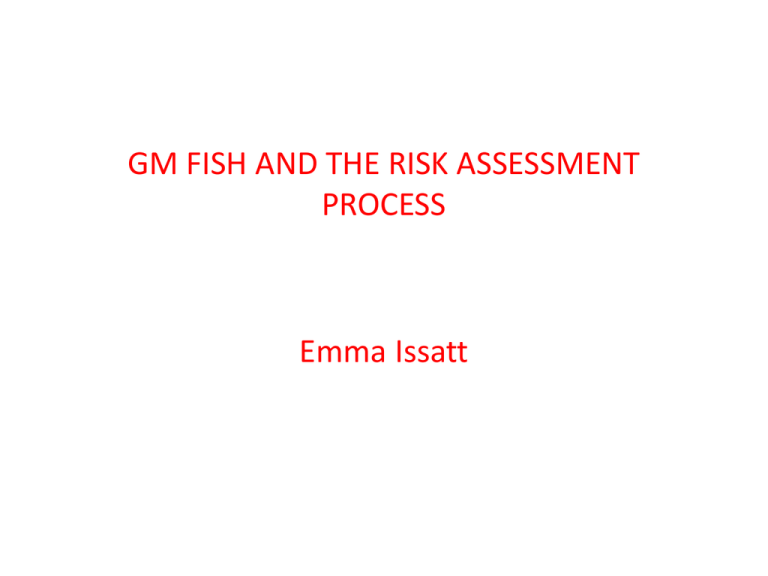
GM FISH AND THE RISK ASSESSMENT PROCESS Emma Issatt AquAdvantage® salmon from Aqua Bounty Technologies Cartagena Protocol on Biosafety 2000 • scientifically sound • taking into account recognized risk assessment techniques • to identify and evaluate the possible adverse effects of living modified organisms on the conservation and sustainable use of biological diversity, taking also into account risks to human health. • Article 15 RISK ASSESSMENT Cartagena Protocol on Biosafety 2000 • regulate, manage and control risks identified in the risk assessment provisions of this Protocol associated with the use, handling and transboundary movement of living modified organisms. Article 16 RISK MANAGEMENT Cartagena Protocol on Biosafety 2000 • Risk assessment should be carried out in a scientifically sound and transparent manner, and can take into account expert advice of, and guidelines developed by, relevant international organizations. • Lack of scientific knowledge or scientific consensus should not necessarily be interpreted as indicating a particular level of risk, an absence of risk, or an acceptable risk. Annex III RISK ASSESSMENT General principles 3, 4. Background to Risk Assessment • 1962 “Silent Spring” by Rachel Carson • 1969 US NEPA -> EIS • 1970 US Occupational Health & Safety Admin. • 1972 “Limits to Growth” • 1973 UK Ecology Party • 1974 UK Health & Safety Commission -> – COSHH (Control of Substances Hazardous to Health) Common Properties of Risk Assessment Process IDENTIFICATION ESTIMATION EVALUATION | Risk Cost Benefit Analysis Social Preferences I & II Comparison Limitations to Risk Assessment Subjective Error Deviations Type I & Type II errors Type of Error What is it? False premise Who bears the burden of the error? Type I False -ive GM fish not safe in open water Industry Type II False +ive GM fish safe in open water Society/Environment Limitations to Risk Assessment Subjective Error Deviations Type I & Type II errors Human error Bias values Guesswork Fraud Risk Assessment and Uncertainty • • • • Complex system Linear thinking v diffuse effects Beck on 3 ways that R A fails new technologies Bayesian principles of risk evaluation “The public are idiots” Governmental faith in science • DAD- ‘decide, announce, defend’ • The public need to be persuaded • EC ‘Life Sciences & Biotechnology- a Strategy for Europe’ 2002 • Arrogance • Probabilistic Strategy • Public’s rational fear “Governments are idiots” Public mistrust • PABE- ‘Public Perceptions of Agricultural Biotechnologies in Europe’ Wynne, Lancaster University, UK “Governments are idiots” Public mistrust • • • • • • PABE Stakeholder myths Eurobarometer Wynne- dictatorial nature of scientists Collins & Pinch on the public understanders C&P on those who venerate science Only scientist in Commons 'alarmed' at MPs' ignorance By Nigel Morris, Deputy Political Editor Tuesday, 3 August 2010 The only scientist in the House of Commons has called for all MPs to be required to take a crash course in basic scientific techniques. Julian Huppert, a research biochemist who became the Liberal Democrat MP for Cambridge at the last election, said he was alarmed at the lack of scientific knowledge among colleagues. Related articles Government ignored our advice on homeopathic remedies, say experts David Colquhoun: These misleading beliefs are curing no one's ills Risk Assessment and Judicial Review • Jasanoff: Science Policy Paradigm • Deference- Ethyl Corp v EPA at appeal: [If legislation allows regulator the] flexibility to assess risks and make essentially legislative policy judgments, as we believe it does, preventive regulation based on conflicting and inconclusive evidence may be sustained.” “The Administrator may apply his expertise to draw conclusions from suspected, but not completely substantiated, relationships between facts, from trends among facts, from theoretical projections from imperfect data, from probative preliminary data not yet certifiable as "fact," and the like.” Risk Assessment and Judicial Review • Jasanoff: Science Policy Paradigm • Deference • ‘Hard look’ doctrine Ethical Considerations in RA • Transfer of risk • Consent to risk Risk Assessment of GM fish • Life Cycle Assessment of GM Medaka fish Risk Assessment of GM fish • Environmental Risk Assessment of Genetically Modified Organisms Volume 3 Methodologies for Transgenic Fish ed. Kapuscinski et al • “Risk assessment should involve all interested and affected parties (the stakeholders), incorporating their perspectives and knowledge, to ensure that the process produces a socially, as well as scientifically acceptable, outcome.” • “Stakeholder participation can enhance legitimacy and public trust of the risk assessment conclusions and improve the quality of the assessment. This is because people with diverse experiences can provide information and insights that a technically oriented team of scientists and risk analysts simply cannot have.” p.273 ‘Major messages from the book’ GMO ERA PROJECT • “a pioneering initiative driven by public sector scientists to develop tools to support environmental risk assessment (ERA) of genetically modified organisms (GMOs). • “The overarching goal of PFOA is to provide multi-stakeholder deliberation about a GMO technology in relation to other future alternatives. A PFOA interacts with traditional ERA processes and builds upon them to make the overall consideration of the GMO more inclusive and robust. Accordingly, a PFOA serves the additional goals of informing the science of the ERA, assisting in improving the science, and allowing the ERA science to accurately inform multi-stakeholder deliberation.” http://www.gmoera.umn.edu Problem Formulation and Options Assessment (PFOA) • • • • • • 1 Problem Formulation 2 Prioritization & Scale of Problem 3 Problem Statement 4 Recommendation to Move Forward 5 Option Identification 6 Assessment in Relation to the Technology and the Problem • 7 Changes Required and Anticipated • 8 Adverse Effects • 9 Recommendation Malaysia PFOA Workshop on Transgenic Fish: Representatives from Chile, China, Cuba, and Thailand • “it provides a systematic way to integrate scientific evidence and public interests… • Participants often adapt their views as their understanding of the issues deepens… • Because information used in a PFOA needs to be presented in terms that are broadly understood, it is also relatively easy to link the PFOA to a broader education effort to help the public understand the significance of risk assessment and biosafety.” PFOA Handbook www.gmoera.umn.edu The End Thank you!
